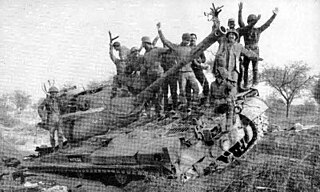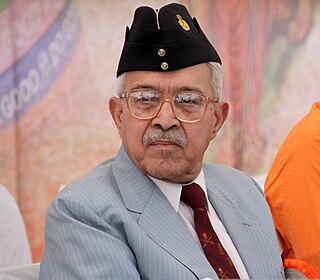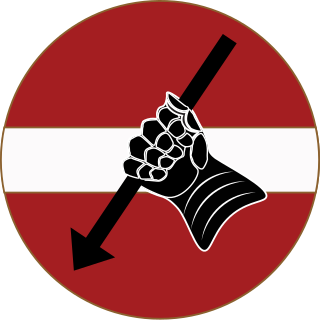
The VII Army Corps of the United States Army was one of the two principal corps of the United States Army Europe during the Cold War. Activated in 1918 for World War I, it was reactivated for World War II and again during the Cold War. During both World War II and the Cold War it was subordinate to the Seventh Army, or USAREUR and was headquartered at Kelley Barracks in Stuttgart, West Germany, from 1951 until it was redeployed to the US after significant success in the Gulf War in 1991, then inactivated in 1992.

The III Corps is a formation of the Indian Army that was formed during World War I in Mesopotamia during its respective campaign. Prior to the reorganization of the British and Indian forces in Mesopotamia, it was designated as the Tigris Corps.

The Parachute Regiment is an airborne and special forces regiment of the Indian Army. It was raised in 1945 as part of the British Indian Army but was disbanded after World War II and was re-raised in 1952 as part of the Indian Army. Currently it consists of fifteen Special Forces, two Territorial Army and one Rashtriya Rifles battalions.

The Pakistan Army, commonly known as the Pak Army is the land service branch and the largest component of the Pakistan Armed Forces. The president of Pakistan is the supreme commander of the army. The Chief of Army Staff (COAS), a four-star general, commands the army. The Army was established in August 1947 after Pakistan gained independence from the United Kingdom. According to statistics provided by the International Institute for Strategic Studies (IISS) in 2024, the Pakistan Army has approximately 560,000 active duty personnel, supported by the Pakistan Army Reserve, the National Guard and the Civil Armed Forces. Pakistan Army is the sixth-largest army of the world and the largest of the Muslim world.

The Battle of Basantar, also known as the Battle of Shakargarh or Battle of Barapind, was one of the vital battles fought as part of the Indo-Pakistani War of 1971 in the western sector of India. The Indian troops won a hard-fought battle that secured this area in the Punjab/Jammu sector. The name Battle of Basantar actually encompasses the entire gamut of battles and skirmishes fought in the Shakargarh sector.

The Battle of Chawinda was a major engagement between Pakistan and India in the Second Kashmir War as part of the Sialkot campaign. It is well known as being one of the largest tank battles in history since the Battle of Kursk, which was fought between the Soviet Union and Nazi Germany in World War II.

Lieutenant General Mohammad Ahmed Zaki is a former general officer of the Indian Army.
The 11th Infantry Division is an active formation of the Pakistan Army. It is currently deployed in Lahore as part of IV Corps, and is responsible for the defence of that city and the surrounding areas.

The XI Corps is a field corps of the Pakistan Army, headquartered in Peshawar, Khyber-Pakhtunkhwa in Pakistan.

The 7th Infantry Division, also known as the Golden Arrow and Peshawar Division, is one of the Pakistan Army's oldest and most battle-hardened division. The officers and men of the Golden Arrow Division have fought in all of Pakistan's Wars and have an unmatched combat service record.
12th Infantry Division, the largest Pakistani Army infantry division, is currently based in Murree, Punjab close to Azad Kashmir. The Chinar Division's headquarters are located in the Murree Hills Cantonment. The brigades of 12th Division are deployed all across Azad Jammu Kashmir and the Line of Control. With 6 Infantry Brigades, 1 Divisional Artillery brigade and a number of supporting units of Air Defence, Supply, Engineering, Signals and Remount & Veterinary Corps under its command, 12th Infantry division is the largest division of Pakistan Army.

The X Corps is a field corps of Pakistan Army, currently headquartered in Chaklala Cantonment, Punjab, Pakistan. Together with the I Corps, it has an area of responsibility and responsibility to protect the Kashmir region— the side only which Pakistan administrates.

The XII Corps is a field corps of the Pakistan Army currently headquartered in Quetta, Balochistan in Pakistan.

The XXX Corps is a field corps of the Pakistan Army, currently stationed in Punjab in Pakistan.

The IV Corps is a field corps of the Pakistan Army, headquartered in Lahore, Punjab, Pakistan. Having established in January 1966, it is Pakistan army's of one of ten field corps formations which saw its deployment against the Indian Army in 1971.

The II Corps is a field corps of the Pakistan Army headquartered in Multan Cantonment, Punjab in Pakistan. It is one the ten field corps formations of the Pakistani military which has seen deployments against the Indian Army in 1971 towards east and the Afghan war to enforce national defenses in west of Pakistan.

The structure of the Pakistan Army is based on two distinct themes: operational and administrative. Operationally the Pakistan Army is divided into nine corps and three corps-level formations with areas of responsibility (AOR) ranging from the mountainous regions of the north to the desert and coastal regions of the south. Administratively it is divided in several regiments. The General Headquarters (GHQ) of the Army is located in Rawalpindi in Punjab province. It is planned to be moved to the capital city of Islamabad nearby.
The Eastern Command of the Pakistan Army was a corps-sized military formation headed by a lieutenant-general, who was designated the Commander Eastern Command. After the partition of India by United Kingdom, the Islamic Republic of Pakistan was divided into two territories separated by 1,000 miles (1,600 km). Most of the assets of the Pakistan armed forces were stationed in West Pakistan; the role of the Pakistan armed forces in East Pakistan was to hold that part of the country until the Pakistani forces defeated India in the west. The Pakistan Army created the Eastern Command, with one commander in the rank of Lieutenant General responsible for the command. The armed forces, had drawn up a plan to defend Dhaka by concentrating all their forces along the Dhaka Bowl.

The Commander-in-Chief of the Pakistan Army was the professional head of the Pakistan Army from 1947 to 1972. The C-in-C was directly responsible for commanding the army. It was an administrative position and the appointment holder had main operational command authority over the army.

The 54th Infantry Division is an Infantry division of the Indian Army. The Division was raised as an Infantry Division, but was converted into a Reorganised Amphibious Formation (RAMFOR) in 2011. It is currently the only division of the Indian Army which carries out Amphibious warfare. The division is headquartered at Secunderabad in Telangana and is a part of XXI Corps. The Division is commanded by an Officer of the rank of Major General titled General Officer Commanding (GOC).















